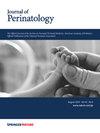Impact of a patent ductus arteriosus on non-invasive pre- and post-ductal blood pressures in extremely preterm infants during the first two postnatal weeks
IF 2.4
3区 医学
Q2 OBSTETRICS & GYNECOLOGY
引用次数: 0
Abstract
To evaluate pre- and post-ductal blood pressure (BP) in preterm infants according to patent ductus arteriosus (PDA) status obtained from targeted neonatal echocardiography (TnECHO). Retrospective cohort study of infants born at 22–28 weeks divided according to three groups: (i) No PDA, (ii) Low volume shunt, (iii) Moderate-high volume shunt. BP parameters, demographics, and clinical characteristics were compared. A total of 373 TnECHOs were included: 98 no PDA, 152 low volume shunt, and 123 moderate-high volume shunt. TnECHOs with no PDA had higher systolic, diastolic, and mean BP. Diastolic flow reversal in the post-ductal descending aorta was associated with lower post-ductal diastolic (p < 0.001) and mean BP (p < 0.001). Moderate-high volume shunt had higher rates of diastolic hypotension. BP patterns varied according to PDA status. Post-ductal hypotension was more common with a moderate-high volume shunt. PDA status in this population may be the strongest influencer of BP variability.

求助全文
约1分钟内获得全文
求助全文
来源期刊

Journal of Perinatology
医学-妇产科学
CiteScore
5.40
自引率
6.90%
发文量
284
审稿时长
3-8 weeks
期刊介绍:
The Journal of Perinatology provides members of the perinatal/neonatal healthcare team with original information pertinent to improving maternal/fetal and neonatal care. We publish peer-reviewed clinical research articles, state-of-the art reviews, comments, quality improvement reports, and letters to the editor. Articles published in the Journal of Perinatology embrace the full scope of the specialty, including clinical, professional, political, administrative and educational aspects. The Journal also explores legal and ethical issues, neonatal technology and product development.
The Journal’s audience includes all those that participate in perinatal/neonatal care, including, but not limited to neonatologists, perinatologists, perinatal epidemiologists, pediatricians and pediatric subspecialists, surgeons, neonatal and perinatal nurses, respiratory therapists, pharmacists, social workers, dieticians, speech and hearing experts, other allied health professionals, as well as subspecialists who participate in patient care including radiologists, laboratory medicine and pathologists.
 求助内容:
求助内容: 应助结果提醒方式:
应助结果提醒方式:


